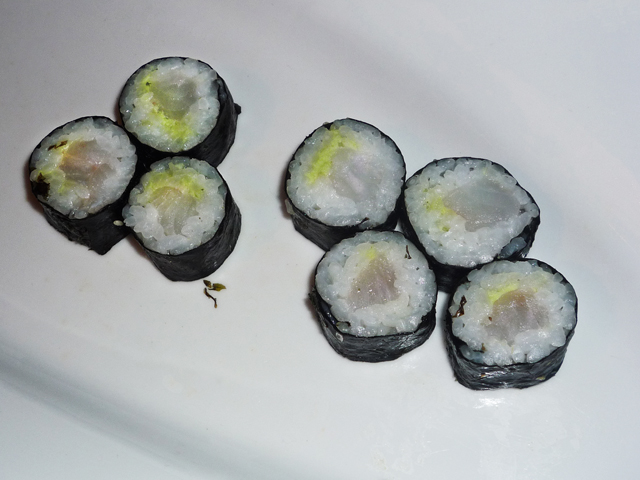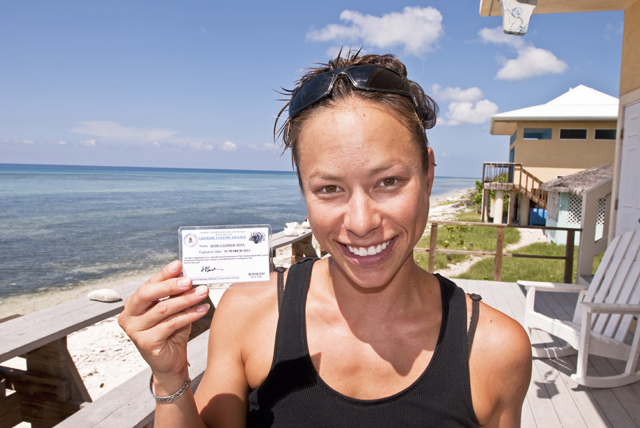Marine Life & Conservation Blogs
Licensed to Cull
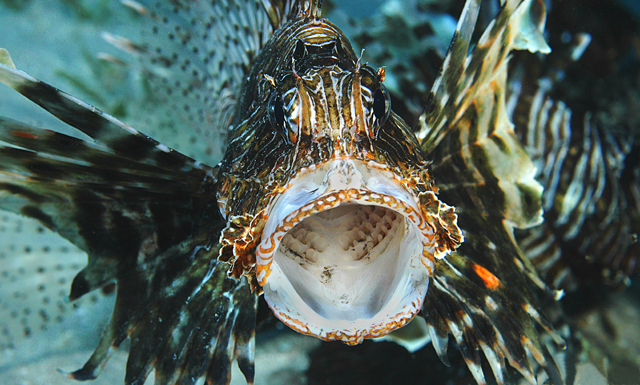
Over the past few years lionfish have been dominating the news headlines. In fact they are probably the most talked about marine species in the Caribbean. There are even ‘wanted’ posters on display in many dive centres. But these posters are not advertising underwater photography or promoting marine life; they are basically ‘kill on sight’ orders.
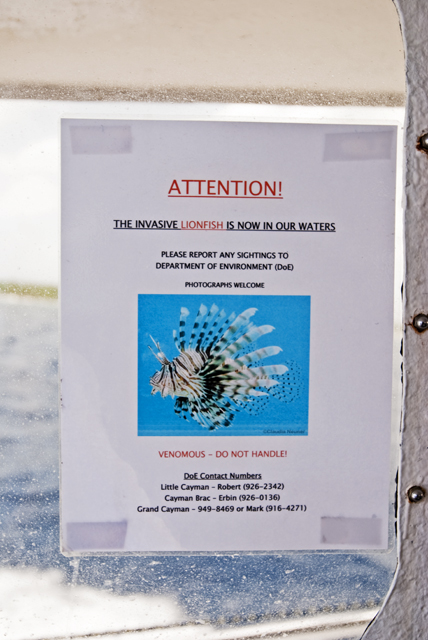 In the Red Sea lionfish (Pterois volitans) are extremely popular with divers. Their bold stripy colours and large venomous spines look great in photographs and they are fascinating to watch, especially when hunting in packs. But the Atlantic Ocean is not their home territory and what’s deemed as an attraction on one continent is seriously threatening the very existence of another.
In the Red Sea lionfish (Pterois volitans) are extremely popular with divers. Their bold stripy colours and large venomous spines look great in photographs and they are fascinating to watch, especially when hunting in packs. But the Atlantic Ocean is not their home territory and what’s deemed as an attraction on one continent is seriously threatening the very existence of another.
During a recent trip to the Cayman Islands I spoke with Flower Moye, a researcher for the CCMI (Central Caribbean Marine Institute) based on Little Cayman. She said that the most likely theory is the whole disaster had been caused by a freak accident. Flower said the Caribbean ‘strain’ had probably been released by aquariums somewhere near Miami. They are now sweeping from island to island heading due south. Some have even been reported as far away as Belize. Flower said “we are not sure where they are or where they are going”. She thinks the present crisis could have been caused by as little as 6 original lionfish. She also thought they were dealing with 2 separate species.
Flower said that the Caymans are now on a lionfish high alert. The ‘hardcore scramble’ started in 2007. Two researchers from Oregon State University were taken on to solely study lionfish characteristics. They are checking sizes, weights and DNA strings to see where they originated from. Studies have shown that the Caribbean lionfish are actually growing in size. They have already exceeded their normal length by a massive 15cm and are still getting bigger. This invasive species has no natural enemies so are just decimating one reef after another. Flower said “no one was prepared or expected such an aggressive full on attack”.
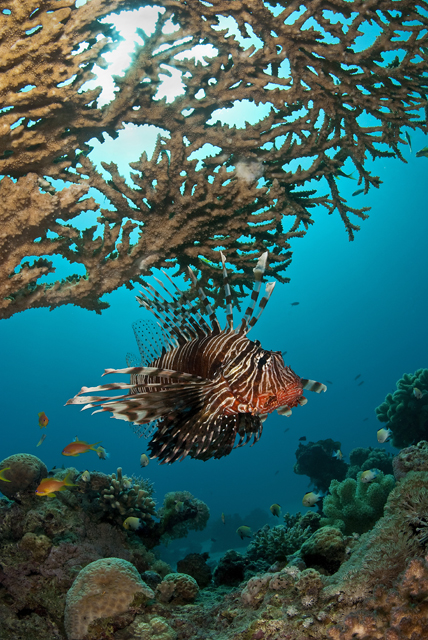
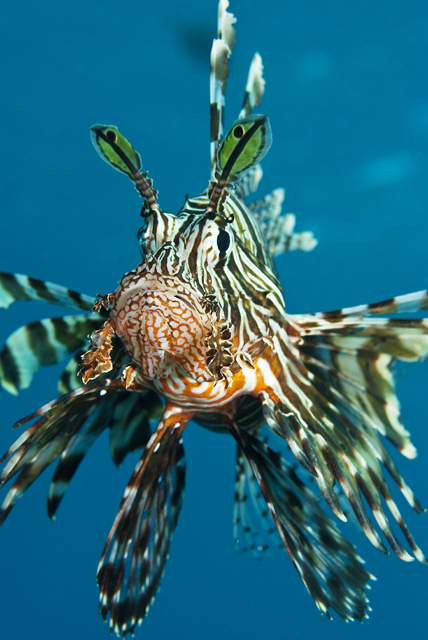 The alien invasion has now reached critical levels and is threatening the whole eco-system. Lionfish are just eating their way through entire cleaning stations. Flower said a dissected specimen had more than 32 fish in its stomach. The local fish population just don’t know how to react. The voracious predator is herding up the unsuspecting fish using their spines and then it’s a full on feeding frenzy. Divers recorded one individual eating 20 juveniles in 30 minutes. Their main targets are damsels and cardinals but every species is under threat. Flower said that the survival rate for reef inhabitants has reduced by a staggering 80 percent. This has a huge knock on effect. The loss of grazers like parrotfish means seaweeds and algae can thrive. This will eventually overwhelm the coral reefs.
The alien invasion has now reached critical levels and is threatening the whole eco-system. Lionfish are just eating their way through entire cleaning stations. Flower said a dissected specimen had more than 32 fish in its stomach. The local fish population just don’t know how to react. The voracious predator is herding up the unsuspecting fish using their spines and then it’s a full on feeding frenzy. Divers recorded one individual eating 20 juveniles in 30 minutes. Their main targets are damsels and cardinals but every species is under threat. Flower said that the survival rate for reef inhabitants has reduced by a staggering 80 percent. This has a huge knock on effect. The loss of grazers like parrotfish means seaweeds and algae can thrive. This will eventually overwhelm the coral reefs.
Grand Cayman Authorities have realised the seriousness of the problem and are responding rapidly. It’s basically a case of exterminate or be exterminated. They have given divers the authorisation to actively seek out and destroy as many lionfish as possible. But before being issued with a license to cull they have to first sit through an hour long Powerpoint presentation. This explains the reasons behind the drastic measures, how to catch them (without getting stung) and what to do with them afterwards. Flower said the most humane way of killing them is to put them in the freezer so that they ‘go to sleep’ and then bury them on land or eat them.
Some divers are even grilling lionfish steaks on the barbecue but obviously the poisonous spines have to be cut off with scissors before the fleshy parts can be sliced up into pieces. Gladys, the owner of Pirates Point on Little Cayman, had prepared some lionfish Sushi for me. I tried a few pieces and although it had a strange twangy taste, it wasn’t at all offensive or inedible. Adding some Wasabi was all it took to spice up the flavour and make it palatable. At Cobalt Coast resort they invited me to a lionfish cook out where I tried all sorts of dishes from deep fried goujons to an extremely tasty bouillabaisse. At least lionfish was proving good to eat!
Dive guides are even trying to ‘train’ the local Nassau grouper population to eat the lionfish. Laura, an Instructor working at the Little Cayman Beach resort, dropped a freshly caught lionfish in front of a grouper and after a few seconds of deliberation it decided to take a bite. But unless the lionfish are actually placed in front of them they don’t seem to be interested. It’s just not seen as a natural food source.
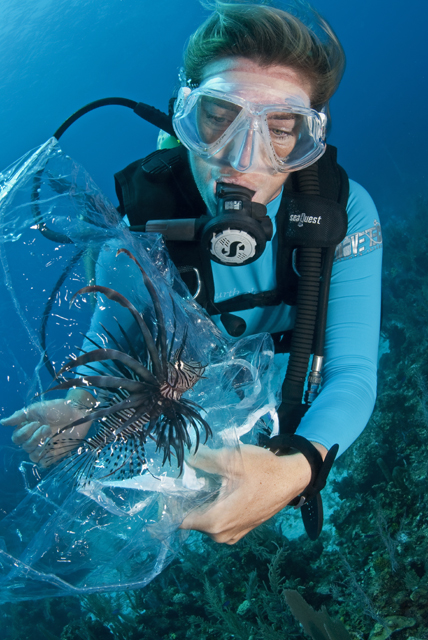 I went for a quick dive with Laura hunting for lionfish and within 10 minutes we managed to find one under a coral mount. Laura scooped the lionfish into a plastic bag and then put it into an ice box back on board the boat. All sightings are reported to the D.O.E. so they can get a good idea where they are and in what numbers. But lionfish are proving a tough species to eradicate. They adapt very quickly. At one dive site I searched below 40 metres and found a number of big 20 – 30cm lionfish lurking underneath ledges all along the wall. I’m sure they had cottoned on that recreational divers don’t usually go this deep so there was less likelihood of being caught.
I went for a quick dive with Laura hunting for lionfish and within 10 minutes we managed to find one under a coral mount. Laura scooped the lionfish into a plastic bag and then put it into an ice box back on board the boat. All sightings are reported to the D.O.E. so they can get a good idea where they are and in what numbers. But lionfish are proving a tough species to eradicate. They adapt very quickly. At one dive site I searched below 40 metres and found a number of big 20 – 30cm lionfish lurking underneath ledges all along the wall. I’m sure they had cottoned on that recreational divers don’t usually go this deep so there was less likelihood of being caught.
The licenses are proper looking ID cards complete with a head and shoulders photograph of the holder. The culling is being promoted as a form of ‘pest control’. But numbers are still growing at an incredible rate. Lionfish can release up to 30,000 eggs a month which equates to more than 2,000,000 eggs every year. Flower said that when they grow to a size of 10cm they are ready to spawn and from then on will keep spawning every 4 days for the rest of their lives! At present there seems to be very little information available on mating habits etc. The only way of finding out the sex of each individual fish is to dissect it. Flower estimates that numbers around Little Cayman are in the high hundreds but this is considered to be a very conservative estimation. In 2008 a researcher caught a total of 197 Lionfish in a small defined area.
At present there is no long term solution to the Lionfish catastrophe. These underwater terminators are not afraid of anything and literally can’t be stopped. In other parts of the world reef fish have learnt to avoid them and there are more natural predators like groupers or stonefish keeping population levels in check. Unfortunately Caribbean grouper numbers have fallen dramatically due to overfishing. This situation requires a more drastic approach but introducing another ‘alien’ species specifically to kill the lionfish is not seen as a good idea. Flower said “Having 2 invasives will not solve the problem and could in fact just make the situation a whole lot worse”. And so the war continues….
Blogs
Saba’s Plan for a Coral Comeback

Saba has an exciting new initiative to restore its coral reefs. This new project, running from 2024 to 2026, will focus on reviving key species in the island’s underwater ecosystems. With a collaborative team from the Saba Conservation Foundation (SCF) and Van Hall Larenstein (VHL) University of Applied Sciences, the project aims to restore both corals as well as sea urchins.
This initiative is centered around coral restoration, specifically reviving two essential coral species—staghorn coral (Acropora cervicornis) and elkhorn coral (Acropora palmata). By mapping parent colonies and using a technique known as coral gardening, SCF will create and maintain coral nurseries. These corals will eventually be outplanted at key reef sites around Saba to not only expand the number of coral colonies, but also provide essential fish habitat. The project focusses on installing coral nurseries, training staff with the newest techniques and starting with the restoration of key reef sites.

Reef Cleaners to the Rescue
It’s not just corals getting a makeover—this project also shines a spotlight on the essential role of grazers, particularly sea urchins. VHL is leading the charge on cultivating and restocking two key sea urchin species, West Indian sea egg (Tripneustes) and long-spined sea urchin (Diadema), known for their ability to keep algae in check. By removing algae, which are important competitors of corals, they help the coral to thrive. By restoring these “reef cleaners,” Saba’s project will give corals the breathing room they need to grow, setting the stage for a healthier, more balanced marine ecosystem.
From Tiny Urchins to Big Goals
The project will be funded as part of the Dutch Government’s Nature and Environment Policy Plan (NEPP) 2020-2030 for the Caribbean Netherlands, a comprehensive initiative aimed at conserving and restoring the unique natural environments of the Dutch Caribbean islands, including Saba, St. Eustatius, and Bonaire. This project is aiming for big milestones: build and maintaining coral nurseries, the expansion of urchin cultivation facilities, and the creation of a dedicated research center. By 2026, the project hopes to ramp up coral and grazer restoration, with the ultimate goal of extending these efforts across the Dutch Caribbean. By linking local initiatives to broader regional goals, Saba’s restoration project promises to leave a lasting impact on both the environment and the community.
Find out more about the DCNA at dcnanature.org.
Blogs
Reef-World marks two decades of marine conservation: strengthening impact amid coral reef threats

Empowering ocean stakeholders to tackle future challenges and ensure the survival of coral reefs and humanity
2024 marks the 20th Anniversary of The Reef-World Foundation’s tireless efforts for global coral reef conservation. The UK charity is the international coordinator of the UN Environment Programme’s Green Fins initiative, known as the leading voice in sustainable marine tourism. Today, Reef-World released its 2023-2024 Impact Report outlining a year of substantive growth and impact in its marine conservation programmes.

Impact Report Highlights:
- Impressive improvements in environmental behaviours to protect coral reefs by the marine tourism industry as the global participation of Green Fins increases.
- Continued capacity building for government and NGO staff to effectively manage marine tourism activities in Asia, Caribbean and Red Sea regions.
- For the first time in Green Fins’ 20-year history, tourism operators have achieved ‘Best Environmental Performer’ status by demonstrating the lowest possible environmental impact in their environmental assessments. In 2024, three dive operators achieved this challenging milestone.
- Significant increases in global participation of Reef-World’s innovative digital conservation tools.
- 138 Green Fins dive operator members achieved the strict threshold for PADI Eco Center recognition.
- Developed four new educational materials and translated two into 16 languages to support the marine tourism industry in achieving sustainability targets.
- Establishing a new Reef-World Development strategy and recruiting new roles – Development and Programmes Managers.
- Reef-World’s board welcomes new Chair and Trustees strengthening organisational leadership.

Reef-World started as a one-person mission to inspire and empower communities to act in conserving and sustainably developing coral reefs and related ecosystems. Today, the team of 12 continues to meet this mission by inspiring and empowering the global marine tourism community to be exemplary sustainability leaders by using the Green Fins guidelines and tools to simultaneously use and protect the world’s precious reefs.
In April 2024, the fourth global coral reef bleaching event was confirmed. Reef-World’s work has never been more urgent as the marine environment, and the benefits they provide humanity, continue to be eroded by global threats. The reduction of local threats, like those from the marine tourism industry, is an essential step to ensuring a future where coral reefs survive and continue to support the millions of people who depend on their ecosystem benefits. Reef-World’s work buys time for coral reefs and related ecosystems to be resilient to the impacts of global threats.
“Right now our corals are facing the greatest fight of their existence as the terrifying predictions of the steps towards their complete extinction are starting to come true. But all is not lost, reefs are resilient and they have existed on this planet for millions of years. We must take action now, to buy time for reefs by reducing threats facing them and allowing them to react and adjust to the changing environment they need to survive in.” – Chloe Harvey, Executive Director
Looking Forwards:
Like coral reefs, the Reef-World team needs to be resilient in the face of the complex challenges of the conservation sector. Reef-World has invested significantly in developing a Culture of Care to ensure the well-being of its team on a daily basis, continuing to be an exemplary employer to enable its team to best achieve the mission for coral reef conservation.
With the foundations of a Culture of Care and organisational development laid, Reef-World is emerging from the end of a natural organisation life cycle, that brings the challenges of growth and scale, stronger than ever. With a new strategy in place to generate much needed resources, Reef-World is excited for the opportunities to leap forward, continue to scale our impact and lean into new innovations and untapped opportunities for marine conservation.
We continually strive to become a forward-thinking organisation that delivers on our goals and commitments to our stakeholders with fresh approaches and not being afraid of steering away from a “normal approach.” This approach is not only applied to our programmes of work but also internally and carries over to our Culture of Care for our team.” — JJ Harvey, Operations Director

The Reef-World Foundation is immensely grateful for the continued support of its grant funders: UN Environment Programme, IUCN’s Blue Natural Capital Financing Facility, Adventure Travel Conservation Fund, PADI Aware Foundation, and World Nomads Footprints Program.
Reef-World would also like to express its gratitude to international partners whose vital support has resulted in significant tangible benefits for our work and mission: PADI; Professional SCUBA Schools International (PSS); Explorer Ventures; 1% for the Planet; ZuBlu; Snorkel Venture, GSTC; Dive O’Clock; Seven Dragons; DiveAssure and Eco Beach, without whom these achievements would not be possible.
The full 2023–2024 Annual Impact Report is available on Reef-World’s website.
-

 News2 months ago
News2 months agoIconic SS United States to become the World’s Largest Artificial Reef
-

 News3 months ago
News3 months agoBook Review – 52 Assignments: Underwater Photography
-

 Gear News3 months ago
Gear News3 months agoDYNAMICNORD – New German diving brand enters the British market
-

 News3 months ago
News3 months agoExploring Cenote El Pit: A Diver’s Dream
-

 Gear News3 months ago
Gear News3 months agoTry BARE drysuits (and maybe even win one!) this Friday with Sea & Sea at North West Dive Fest
-

 Marine Life & Conservation3 months ago
Marine Life & Conservation3 months agoBook Review: Coral Triangle Cameos
-

 Blogs2 months ago
Blogs2 months agoDive the Egyptian Red Sea this Autumn with Regaldive
-

 News3 months ago
News3 months ago2024 Ocean Art Underwater Photo Competition Announced


